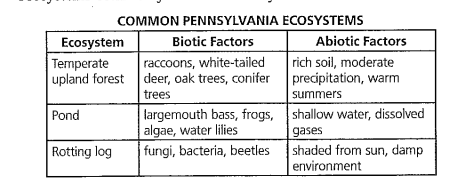
Ecology
Objectives:
1. Be able to Identify and describe the levels of ecological organization
2.Describe how energy flows through an ecosystem
3. Describe biotic interactions in an ecosystem
Essential Questions:
1. What are the levels of the ecological organization?
2. How does energy flow through an ecosystem?
3. What are the biotic interactions in an ecosystem?
Key terms:
Ecology- The study of the relationships between organisms and their environment
Biotic- A living component of an ecosystem
Abiotic- Non-living chemical and physical factors in the environment
Terrestrial- Biomes are confined to land
Aquatic- Aquatic biomes consist of bodies of water or ocean zones
Salinity- Refers to the concentration of salts in water
Biomes- Community of plants and animals that have similar characteristics for the environment that they live in
Competition- Occurs when organisms seek the same limited resource
Symbiotic Relationship- Individuals of different species live closely together
Mutualism- Two organisms of different species that work together and each benefit from the relationship
Parasitism- One organism benefits and the other is harmed
Producers- Able to make their own food through photosynthesis
Consumers- Organisms that obtain energy by feeding on producers or other consumers
Decomposers- An organism that obtains its energy by breaking down dead and decaying matter
Trophic levels- An organism's trophic level is its position in a food chain or web
Herbivore- A primary consumer that feeds exclusively on plants
Predator- An animal that hunts other animals
Endemic species- Species that are found in their original ecosystems
Nonnative species- Species that are living outside their normal range and compete with native species
Pollution- The addition of substances of substances, objects, or other factors, that cause harmful changes to an ecosystem
Commensalism- Relationship between 2 species where one organism derives benefit without harming the other
Ecology is the study of the relationships between organisms and their environment. There are many different levels of ecological organization, but the smallest one is an organism. All of the populations of different species that share an area make up a community. Organisms interacting with each other and nonliving elements such as sunlight, soil, and the weather makes up and ecosystem. Ecosystems with similar characteristics are grouped into biomes and biomes make up the earth’s biosphere which is the largest level of ecological organization. Ecosystems are made up of both biotic and abiotic factors. The biotic factors are the living parts of the ecosystem including the community and the population. The abiotic factors are the nonliving parts of the ecosystem including temperature, oxygen, sunlight, and etc. Biotic and abiotic factors interact with each other to form ecosystems of different sizes. Biomes can be divided into terrestrial (land) biomes such as a tropical rainforest and aquatic (water) biomes such as an ocean. Aquatic biomes are one of the most important because of the fact that the planet is covered by water. Salinity and sunlight are the two major factors that affect aquatic biomes. Salinity is the salt concentration of water and sunlight penetrates to a certain depth that depends on the clarity of the water. Succession is the process at which an ecosystem changes over time and it occurs after a disturbance or in an that had no soil to begin with. Primary succession occurs on surfaces that didn’t previously support plant life. Secondary succession occurs in areas that have previously supported life such as an affected area. Population sizes change over time with births and the addition of new members from other populations. Just as quick as population sizes can increase they can also decrease because of deaths and individuals leaving the population. The study of these population changes is called population dynamics. Nonnative species live outside their normal range and compete with native species. The round goby is an example of a nonnative species. The round goby is able to blend in with rocks and pebbles and wait for their prey. They are sensitive to movements of water and can feed even in complete darkness. Nonnative species have fewer predators and use available resources more effectively. Limiting factors are able to prevent populations from becoming too large.
Human-caused changes to ecosystems can destroy habitats. Habitat destruction is a leading cause of the extinction of endangered species. Resources are limited in an ecosystem, so populations that require the same resources find themselves in competition. Organisms in a community interact through symbiosis. There are several types of symbiosis such as Mutualism, Commensalism, and Parasitism. Organisms in a community are classified as producers, consumers, or decomposers. The feeding relationship in an ecosystem may be depicted in food chains and food webs. A food chain shows the flow of energy in one sequence of organisms and a food web shows the set of feeding relationships among the populations in a community. Biogeochemical cycles describe the movement of elements among biotic and abiotic components. Photosynthesis removes carbon dioxide from the atmosphere while respiration replaces it, but the carbon cycle includes additional processes. Respiration converts organic carbon in the form of carbohydrates, fat, and proteins to carbon dioxide which is an inorganic compound. Photosynthesis then reverses the process to produce organic carbon. The nitrogen cycle is the movement of nitrogen between the atmosphere, the soil, and living things. Freshwater moving between the atmosphere, earth’s surface, and organisms is a process called The Water Cycle.
Multiple Choice and Open-ended Questions
1. What are two major factors that affect aquatic biomes?
A.Commensalism and Mutualism
B. Salinity and Sunlight
C. Carbon dioxide and carbohydrates
D. Endemic and nonnative species
2. Primary succession occurs on surfaces that didn’t previously support plant life
A.True
B. False
3. What are the three types of symbiosis?
A. Producers, consumers, and decomposers
B. Herbivore, Predator, and prey
C. Mutualism, Commensalism, and Parasitism
D. Carbon cycle, Nitrogen cycle, and Water cycle
4. Describe the difference between Abiotic and Biotic factors. Be sure to include examples!
______________________________________________________________________________
______________________________________________________________________________
______________________________________________________________________________
5. Describe the difference between the three types of symbiosis. Include examples for each type
______________________________________________________________________________
______________________________________________________________________________
______________________________________________________________________________






